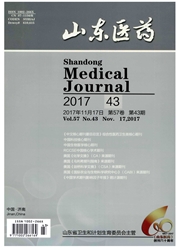

 中文摘要:
中文摘要:
目的探讨(-)-Epigallocatechin3-O—Gallate(EGCG)对大鼠糖尿病肾病模型小管间质性损害以及纤维化的治疗作用。方法取60只Wistar大鼠,高糖、高脂饲料喂养4周后16只作为对照组,另44只组一次性腹腔内注射STZ30mg/kg制作糖尿病肾病模型,将其中39只存活、成膜的大鼠随机分为模型组(n=20)和治疗组(n=19)。各组均予高蛋白饲料喂养,治疗组予EGCG1g/d灌胃。第12周测定各组血糖、糖化血红蛋白(HbAlc)、Cr、BUN,尿β2微球蛋白(β2-MG),ELISA法测定血清TGF-β1水平,荧光分光光度法测定血清血管收缩素转换酶(AGEs)水平;取肾组织行病理检查,免疫组化或免疫荧光法检测肾小管间质TGF—β1、晚期糖基化终产物受体(RAGE)、VEGF表达。结果治疗组上述血清学及尿液指标均明显优于模型组;肾小管问质病理损害明显轻于模型组;肾小管间质中TGF-β1、RAGE、VEGF的表达明显低于模型组;P均〈0.05。结论EGCG能减轻糖尿病肾病模型大鼠肾小管间质损害并下调肾脏纤维化相关因素的表达,其作用机制可能与拮抗氧化应激有关。
 英文摘要:
英文摘要:
Objective To investigate the effects of (-)-Epigallocatechin 3-O-Gallate (EGCG)on tubulointerstitial damage and fibrotic correlation factors in diabetic nephropathy rats. Methods Sixty male wistar rats were fed by high-glu- cose diet for four weeks. All of them were randomly divided into normal control group (A group, n = 16) and diabetic mod- el group (n =44). In the fourth weekend, STZ (30 mg/ kg) was injected into abdominal cavity of rats in diabetic model group. After 48 hours, blood glucose was tested. Thirty nine rats of diabetic model group (survival, qualified and normal appetite) were randomly divided into diabetic nephropathy model group (B group, n-19) and model treatment group (C group) (n = 18). Rats in A, B and C groups were given high-protein diet and each rats in C group was added EGCG lg/ d. At 12th weekend, fasting plasma glucose, HbA1 c, SCr, BUN, 24 h urinary protein and urinary β2-MG were measured. The levels of AGEs and TGF-β1 in serum were determined by fluorospectrophotometry and ELISA. The renal pathological changes were examined and the expressions of TGF-β1, VEGF and RAGE in tubulointerstitial were detected by immunohis- tochemical method and immunofluorescence. Results There were significantly difference among A, B, and C group in fasting plasma glucose, HbAlc, SCr, BUN, 24 h urinary protein and urinary β2-MG, AGEs and TGF-β1. Fasting plasma glucose, HbAlc, SCr, BUN, 24 h urinary protein and urinary β2-MG, AGEs and TGF-13 were significantly higher in B group than those in A group and C group(P 〈 0.05). Renal pathology showed that tubulointerstitial lesion in C group was lessened than B group and expressions of TGF-β1 ,VEGF and RAGE in tubulointerstitial of C group were reduced than B group. Conclusion EGCG could lessen tubulointerstitial damage of diabetic nephropathy in rats and down-regulate the ex- press of fibrotic correlation factors. The renoprotective effects may be related to its inhibition on oxidative stress.
 同期刊论文项目
同期刊论文项目
 同项目期刊论文
同项目期刊论文
 期刊信息
期刊信息
